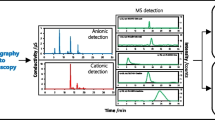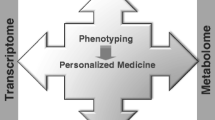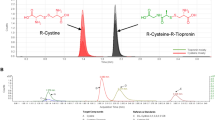Abstract
Current urinary bladder cancer diagnosis is commonly based on a biopsy obtained during cystoscopy. This invasive method causes discomfort and pain in patients. Recently, taurine and several other compounds such as L-phenylalanine and hippuric acid in urine were found to be indicators of bladder cancer. However, because of a lack of sensitive and accurate analytical techniques, it is impossible to detect these compounds in urine at low levels. In this study, using liquid chromatography–tandem mass spectrometry (LC-MS/MS), a noninvasive method was developed to separate and detect these compounds in urine. 15N2-L-glutamine was used as the internal standard, and creatinine acted as an indicator for urine dilution. A phenyl-hexyl column was used for the separation at an isocratic condition of 0.2% formic acid in water and 0.2% formic acid in methanol. Analytes were detected in multiple-reaction monitoring with positive ionization mode. The limit of detection range is 0.18–6 nM and the limit of quantitation ranges from 0.6 to 17.6 nM. The parameters affecting separation and quantification were also investigated and optimized. Proper clinical validation of these biomarkers can be done using this reliable, fast, and simple method. Furthermore, with simple modifications, this method could be applied to other physiological fluids and other types of diseases.



Similar content being viewed by others
References
Sturman JA (1993) Taurine in development. Physiol Rev 73(1):119–147
Fukuda K, Hirai Y, Yoshida H, Nakajima T, Usui T (1982) Free amino acid content of lymphocytes and granulocytes compared. Clin Chem 28(8):1758–1761
Bella DL, Hirschberger LL, Kwon YH, Stipanuk MH (2002) Cysteine metabolism in periportal and perivenous hepatocytes: perivenous cells have greater capacity for glutathione production and taurine synthesis but not for cysteine catabolism. Amino Acids 23(4):453–458
Schuller Levis G, Park E, Gregory SM (2006) Is taurine a biomarker? Adv Clin Chem 41:1–21
Aerts L, Van Assche FA (2002) Taurine and taurine-deficiency in the perinatal period. J Perinat Med 30(4):281–286
Beckonert O, Monnerjahn J, Bonk U, Leibfritz D (2003) Visualizing metabolic changes in breast-cancer tissue using 1H-NMR spectroscopy and self-organizing maps. NMR Biomed 16(1):1–11
De Micheli E, Alfieri A, Pinna G, Bianchi L, Colivicchi MA, Melani A, Pedata F, Della Corte L, Bricolo A (2000) Extracellular levels of taurine in tumoral, peritumoral and normal brain tissue in patients with malignant glioma: an intraoperative microdialysis study. Adv Exp Med Biol 483:621–625
Srivastava S, Roy R, Singh S, Kumar P, Dalela D, Sankhwar SN, Goel A, Sonkar AA (2010) Taurine—a possible fingerprint biomarker in non-muscle invasive bladder cancer: a pilot study by 1H NMR spectroscopy. Cancer Biomark 6(1):11–20
www.wikipedia.com. Accessed 20 May 2011
Gamagedara S, Gibbons S, Ma Y (2011) Investigation of urinary pteridine levels as potential biomarkers for noninvasive diagnosis of cancer. Clin Chim Acta 412(1–2):120–128
Orhan H, Vermeulen NP, Tump C, Zappey H, Meerman JH (2004) Simultaneous determination of tyrosine, phenylalanine and deoxyguanosine oxidation products by liquid chromatography-tandem mass spectrometry as non-invasive biomarkers for oxidative damage. J Chromatogr B Analyt Technol Biomed Life Sci 799(2):245–254
Wang TJ, Larson MG, Vasan RS, Cheng S, Rhee EP, McCabe E, Lewis GD, Fox CS, Jacques PF, Fernandez C, O’Donnell CJ, Carr SA, Mootha VK, Florez JC, Souza A, Melander O, Clish CB, Gerszten RE (2011) Metabolite profiles and the risk of developing diabetes. Nat Med 17(4):448–453
Pero RW (2009) Health consequences of catabolic synthesis of hippuric acid in humans. Curr Clin Pharmacol 5(1):67–73
Xu X, Lan J, Korfmacher WA (2005) Rapid LC/MS/MS method development for drug discovery. Anal Chem 77(19):389A–394A
Long X, Zhang J, Zhang Y, Yao J, Cai Z, Yang P (2009) Nano-LC-MS/MS based proteomics of hepatocellular carcinoma cells compared to Chang liver cells and tanshinone IIA induction. Mol Biosyst 7(5):1728–1741
Cohen MN, Christians U, Henthorn T, Vu Tran Z, Moll V, Zuk J, Galinkin J (2011) Pharmacokinetics of single-dose intravenous ketorolac in infants aged 2–11 months. Anesth Analg 112(3):655–660
Wang C, Shi H, Adams CD, Gamagedara S, Stayton I, Timmons T, Ma Y (2010) Investigation of pharmaceuticals in Missouri natural and drinking water using high performance liquid chromatography-tandem mass spectrometry. Water Res 45(4):1818–1828
Chaimbault P, Alberic P, Elfakir C, Lafosse M (2004) Development of an LC-MS-MS method for the quantification of taurine derivatives in marine invertebrates. Anal Biochem 332(2):215–225
Penner N, Ramanathan R, Zgoda-Pols J, Chowdhury S (2010) Quantitative determination of hippuric and benzoic acids in urine by LC-MS/MS using surrogate standards. J Pharm Biomed Anal 52(4):534–543
Zinellu A, Sotgia S, Scanu B, Chessa R, Gaspa L, Franconi F, Deiana L, Carru C (2009) Taurine determination by capillary electrophoresis with laser-induced fluorescence detection: from clinical field to quality food applications. Amino Acids 36(1):35–41
Ackermann BL, Hale JE, Duffin KL (2006) The role of mass spectrometry in biomarker discovery and measurement. Curr Drug Metab 7(5):525–539
Ciccimaro E, Blair IA (2010) Stable-isotope dilution LC-MS for quantitative biomarker analysis. Bioanalysis 2(2):311–341
Teichert F, Verschoyle RD, Greaves P, Thorpe JF, Mellon JK, Steward WP, Farmer PB, Gescher AJ, Singh R (2009) Determination of 8-oxo-2′-deoxyguanosine and creatinine in murine and human urine by liquid chromatography/tandem mass spectrometry: application to chemoprevention studies. Rapid Commun Mass Spectrom 23(2):258–266
Chung YL, Wassif WS, Bell JD, Hurley M, Scott DL (2003) Urinary levels of creatine and other metabolites in the assessment of polymyositis and dermatomyositis. Rheumatology (Oxford) 42(2):298–303
Csernansky JG, Bardgett ME, Sheline YI, Morris JC, Olney JW (1996) CSF excitatory amino acids and severity of illness in Alzheimer’s disease. Neurology 46(6):1715–1720
Dawson R Jr, Pelleymounter MA, Cullen MJ, Gollub M, Liu S (1999) An age-related decline in striatal taurine is correlated with a loss of dopaminergic markers. Brain Res Bull 48(3):319–324
Nanobashvili J, Neumayer C, Fugl A, Punz A, Blumer R, Prager M, Mittlbock M, Gruber H, Polterauer P, Roth E, Malinski T, Huk I (2003) Ischemia/reperfusion injury of skeletal muscle: plasma taurine as a measure of tissue damage. Surgery 133(1):91–100
Acknowledgments
The authors acknowledge Central Missouri Urology Clinic and volunteers for providing urine samples, and they also thank the Foundation of Chemical Research, the Missouri Research Board, and the Missouri University of Science and Technology for funding.
Author information
Authors and Affiliations
Corresponding author
Rights and permissions
About this article
Cite this article
Gamagedara, S., Shi, H. & Ma, Y. Quantitative determination of taurine and related biomarkers in urine by liquid chromatography–tandem mass spectrometry. Anal Bioanal Chem 402, 763–770 (2012). https://doi.org/10.1007/s00216-011-5491-4
Received:
Revised:
Accepted:
Published:
Issue Date:
DOI: https://doi.org/10.1007/s00216-011-5491-4




